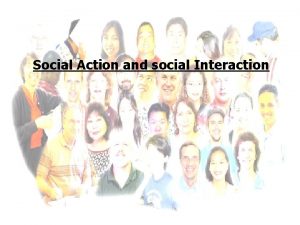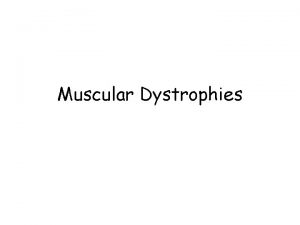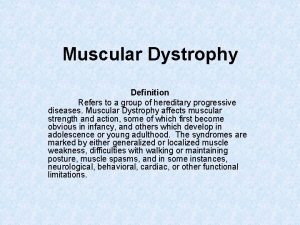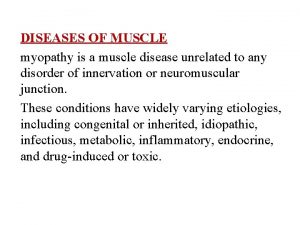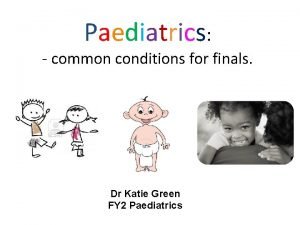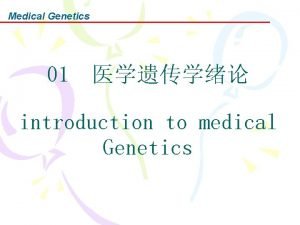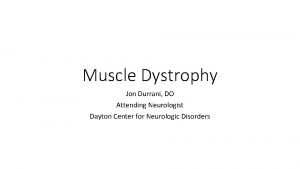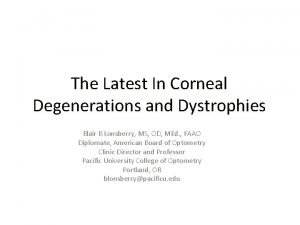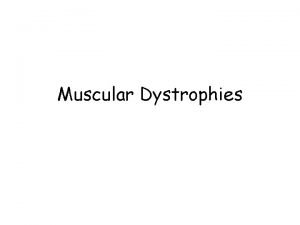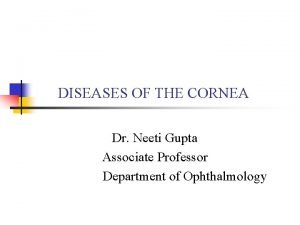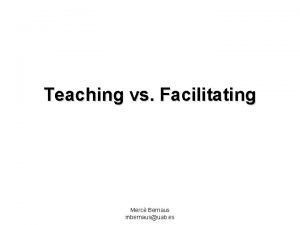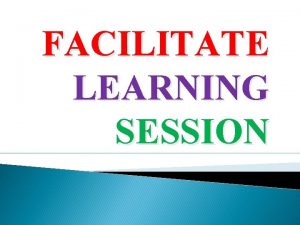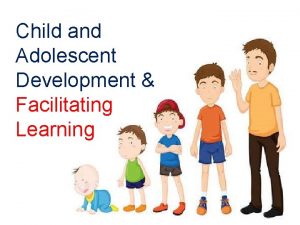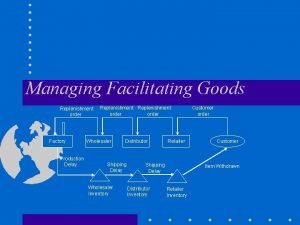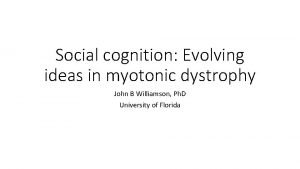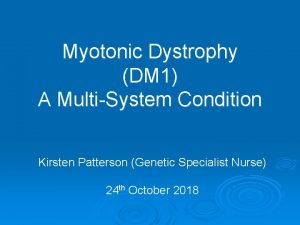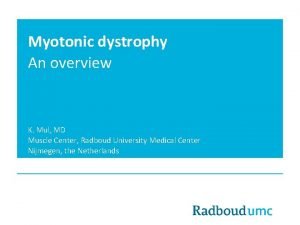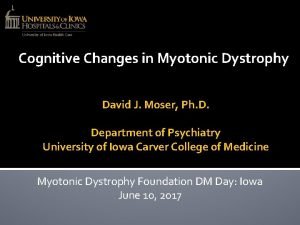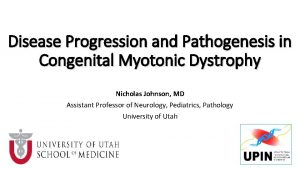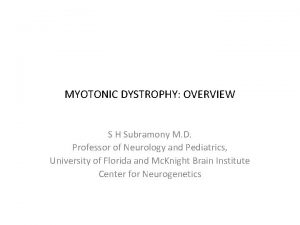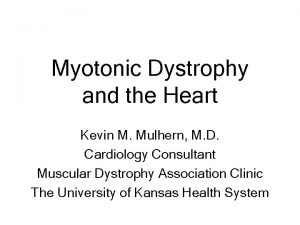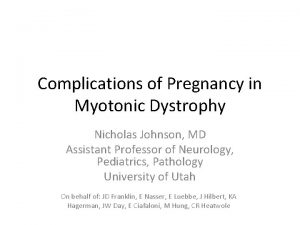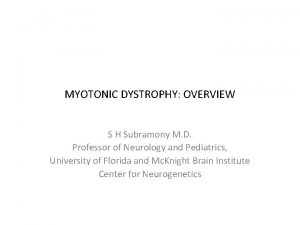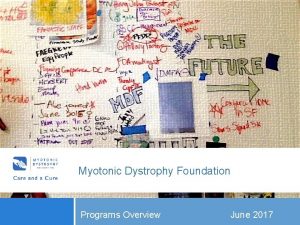Facilitating Social Interaction In Myotonic Dystrophy Melissa M
























- Slides: 24

Facilitating Social Interaction In Myotonic Dystrophy Melissa M. Dixon, Ph. D, MS MDF Support Group Facilitators Presentation March 28, 2019

Disclosures • I have no known financial interests or relationships to disclose that are related to this presentation.

The Importance of Social Connection • Central to well-being • Fulfills a natural human need to belong • Provides sense of purpose, feelings of being supported and valued • Interpersonally connected • Broadens social network/meet new people • Positively impacts quality of life • Opportunities to laugh • Gives Partner/Parent/Caregiver a break • Health benefits

Mental Health Benefits of Social Connection • Improved mental health • Lower rates of depression and anxiety • Perceived lower level of stress • Increased sense of happiness • Increased self-worth and confidence • Greater empathy for others • Better emotional regulation • Decreased risk of suicide • Wider range of coping skills

Physical Health Benefits of Social Connection • Better physical health • • • Boost immune system (Cole, 2013) Decreased inflammation (Cole, 2013) Decreased cardiovascular problems Lower blood pressure Improved nutrition • Lack of social connection greater detriment to health than obesity, smoking and high blood pressure (House et al. , 1988) • Stronger social connection mitigates mortality (Tanskanen & Anttila, 2016) • Feelings of loneliness increase risk of mortality in men (Holwerda et al. , 2018) • Social connection creates a positive feedback loop of social, emotional, and physical well-being

Myotonic Dystrophy: A Multisystemic Disease • Physical, emotional, and cognitive symptoms DM Across the Lifespan Developmental Onset: 0: 0 1: 0 CDM Childhood Degenerative 18: 0 Adult

Illness Experience

Impact of DM on Social Status and Identity Achieved Social Status (gained through effort, talent, accomplishments) Ascribed Social Status (given regardless of abilities) Mother Wife Daughter Female 44 year-old Latina Person with DM Friend Colleague Accountant Professor Athlete Author

Impact of DM on Social Status and Identity • DM contributes to identity and how one thinks about one’s self and who they are in their context of their social environment and in relationships • Diagnosis of DM after identity formation • Difficulty accepting DM • Cognitive symptoms may impact acceptance of DM/disability • Factors contributing to how much of an impact having DM plays on identity • • • Watching others experiences of living with DM, symptoms, and change Social support system Frame of reference: illness defines/ does not define individual Resources Symptoms

Facilitating Social Interaction • Needs and expectations for social activities • Caregiver • Affected individual • Strategies for Success • Identify and understand limitations • • Barriers Symptoms Expectations Communication

Facilitating Social Interaction • Strategies for Success • • • Communication Planning Problem solving Goal setting Flexibility

Needs and Expectations • Caregiver needs (affected individuals do to!) • • Reasonable to need to spend time with loved ones Not selfish Health benefits Meaningful and important • Caregivers and affected individuals have expectations • Normal • Healthy • Okay

Strategies for Facilitating Successful Social Interactions • Chose activities together • Flexibility • Switching between C/P • Activities are important and meaningful • • What activities are important? Why? To whom? Alternatives and modifications

Strategies for Facilitating Successful Social Interactions • Communication • Identify barriers • Planning • Problem solving • Goal setting • Flexibility

Communication Strategies For Success • Communication is key • • • Early and frequent conversations Discuss expectations, needs, what you value Avoid surprises Identify disappointments outside of activity itself Avoid operating in “Crisis Mode” • • Heightened emotions Limited problem solving Disappointments Hurt feelings and misunderstandings

Communication Strategies For Success • “I don’t know response” • Ask for a reframe or different response • Caregivers are not mind readers • Open-ended questions instead of giving yes/no options • Give 1 -2 options that work for both parties • Back-up plan if life intervenes so opportunity is not lost

Identify Barriers to Social Interaction • Physical barriers • • • Physical symptoms Loss of function Environmental barriers Weather-related Activities are not appropriate Limited suitable opportunities • Can accommodations be made?

Identify Barriers to Social Interaction • Emotional and Cognitive Barriers • • • Depression Anxiety Apathy/motivation Personality Changes in thinking, attention, processing, executive function Changes in peer relationships Caregiver/Partner barriers Identity changes Grief • What accommodations can be made? • Don’t take things personally • Working memory- repeat • Taking initiative- don’t wait around to be disappointed • Alternative plans

Careful Planning is Crucial to Successful Social Interactions • Early planning/intervention • Operating in ”Crisis Mode” • Potential possibilities • Problem solve early • Flexibility • Age/Developmentally-appropriate plan • Potential outcomes • Plan solutions • Identify alternatives

Facilitating Social Interaction Though Planning and Problem Solving • Early planning/intervention • Operating in ”Crisis Mode” • Potential possibilities • Problem solve early • Flexibility • Potential outcomes • Goes accordingly • Identify alternatives

Facilitating Social Interaction Though Planning and Problem Solving • Planning is an iterative process: it may take many tries • Social interaction is a developmental process • Developing social skills may be harder for children with developmental delays • Social skills are learned behavior and dependent on reciprocal relationships • Inclusive activities and environments are important • • • Plan with interests, personalities, physical/mental abilities in mind Beneficial to all parties Genuine opportunities to participate May require direct instruction or suggestions Don’t give up too easily- avoid creating learned helplessness

Goal Setting • • • Make goals broad so that can be successful Be open to change- flexible Make short and long term goals Define success (e. g. , participate in social activity once a week, once a month) Re-evaluate goals and success definitions with new information and/or changes in circumstance Don’t engage in either/or thinking, ”I have to, ” or “I should” (that’s being too hard on yourself and others!) • When X does not occur, there is a negative impact and it sends the message to self/others of failure, which can be internalized • Leads to “Why bother” thinking • Identify at least one positive related to every stage/attempt at social activity • Always a success • Allows forward movement and additional opportunities • Avoid comparing interactions/activities and circumstances to previous interactions/circumstances/people- this is not helpful

Facilitating Social Interaction • Flexibility is an important aspect when adapting to change • Lower expectations • Repeat, repeat! • Try out different strategies- not everything works for everyone

Questions? Thank you Missy Dixon, Ph. D, MS Visiting Assistant Professor University of Utah | Department of Pediatrics Missy. dixon@genetics. Utah. edu
 Myotonic dystrophy type ii
Myotonic dystrophy type ii Bionator appliance
Bionator appliance Difference between social action and social interaction
Difference between social action and social interaction Duchenne muscular dystrophy pedigree
Duchenne muscular dystrophy pedigree Duchenne muscular dystrophy
Duchenne muscular dystrophy Nursing diagnosis for muscular dystrophy
Nursing diagnosis for muscular dystrophy Cornea dystrofie
Cornea dystrofie Signs of duchenne muscular dystrophy
Signs of duchenne muscular dystrophy Becker muscular dystrophy
Becker muscular dystrophy Duchenne muscular dystrophy
Duchenne muscular dystrophy Connate rachitis
Connate rachitis Dimples pedigree
Dimples pedigree Gowers sign slideshare
Gowers sign slideshare Marilyn monroe always gets her man in la county
Marilyn monroe always gets her man in la county Duchenne muscular dystrophy
Duchenne muscular dystrophy Fuchs dystrophy
Fuchs dystrophy Duchenne muscular dystrophy
Duchenne muscular dystrophy Emery dreifuss muscular dystrophy
Emery dreifuss muscular dystrophy Vulvar dystrophy thyroid
Vulvar dystrophy thyroid Salzmann's nodular dystrophy
Salzmann's nodular dystrophy Limb girdle muscular dystrophy
Limb girdle muscular dystrophy Teaching vs facilitating
Teaching vs facilitating Benchwork area
Benchwork area Scaffold and fade-away technique
Scaffold and fade-away technique Facilitating goods example
Facilitating goods example


